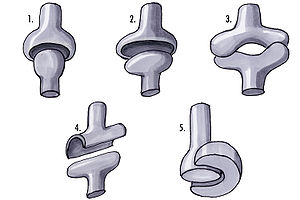Movements in the joint and its types
Joint (Articulatio synovialis)[edit | edit source]
A joint is a movable connection of two or more bones that touch surfaces covered with cartilage inside the joint capsule. As a rule, these surfaces (facies articulares) are formed in such a way that one has a concave shape - the articular socket and the other has a convex shape - the articular head.
Movements in the joint[edit | edit source]
Movements in the joint are divided into active movement, performed by the muscular apparatus, and passive movement, performed by the therapist or gravity. This can help us distinguish whether it is a predominantly joint or muscle disorder during joint examination.
One type of passive movement is "joint play ". The clearance in the joint is defined by the elasticity of the joint capsule and the pull of the short periarticular muscles. We investigate joint clearance into distraction, anterioposterior displacement, laterolateral displacement, rotational movements and angulation.
Classification of movements in joints[edit | edit source]
The classification of joint movements is based on the geometric shape of the contact surfaces and the direction in which they move.
We describe three basic movements between the contact surfaces of the joint:
- rolling motion
- shear movement
- rotation
Furthermore, the movement depends on the number of axes in which the movement takes place and on the number of bones that are part of the joint.
- movement around the X axis (frontal plane) – abduction, adduction
- rotational movement around the Y axis (sagittal plane) – flexion, extension
- movement around the Z axis (transverse plane) – internal, external rotation
the combination of these movements creates circumduction
Types of joints according to the number of axes and the shape of the contact surfaces[edit | edit source]
Joints are divided according to the axes in which they move, into triaxial (multiaxial), biaxial, uniaxial or other joints.
Triaxial joints[edit | edit source]
Movement occurs in all three axes. An example of such a joint is a ball-and-socket joint, where the socket has the shape of a ball. We could further divide the ball-and-socket joint into a free ball-and-socket joint (shoulder joint) and a limited ball-and-socket joint (hip joint), which has a deep socket.
Biaxial joints[edit | edit source]
Movement occurs along the axes of flexion-extension and abduction-adduction.An elliptical joint has surfaces similar to a rotational ellipsoid, an example is the radiocarpal joint. Another biaxial joint is the saddle joint. An example is the carpometacarpal joint of the thumb.
Uniaxial joints[edit | edit source]
Movement occurs only along one flexion-extension axis. This category includes the cylindrical joint, which has contact surfaces in the shape of a cylinder. We distinguish other subtypes:
- hinged joint (ginglymus) - axis of movement perpendicular to the longitudinal axis of the bone
- wheel joint – axis of rotation coincides with the longitudinal axis of the bone (radiulnar joint)
- roller joint – cylindrical joint fitting into the groove on the other bone (humeroulnar joint)
Other types of joints[edit | edit source]
Flat joint - flat contact surfaces, allows sliding in all directions (intervertebral discs). Rigid joint – similar to a flat joint, but with uneven contact surfaces that limit movement (sacroiliac joint).
Links[edit | edit source]
Related literature[edit | edit source]
References[edit | edit source]
- ČIHÁK, R, et al. Anatomie 1. 1. edition. Praha : Avicenum, 1987. 456 pp. pp. 88. ISBN 08-102-87.
- KOLÁŘ, Pavel. Rehabilitace v klinické praxi. 1. edition. Praha : Galén, 2010. 713 pp. pp. 124-126. ISBN 978-80-7262-657-1.



